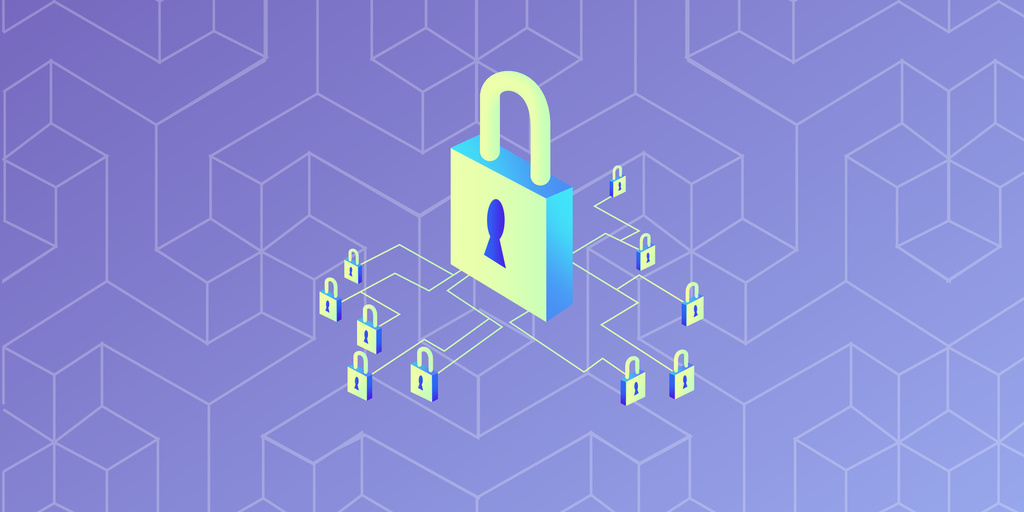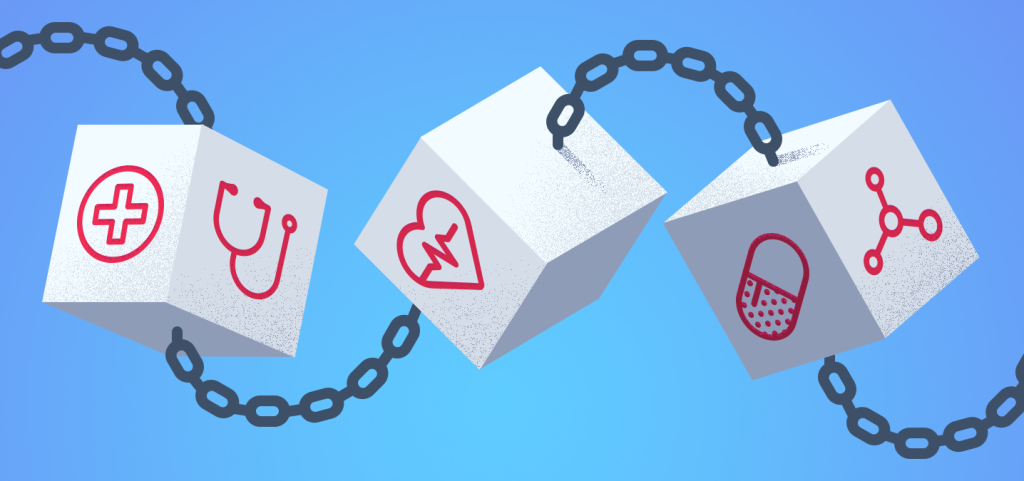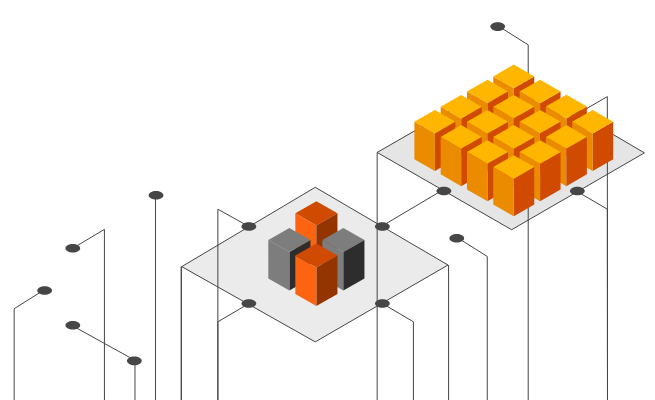The Real Use Case for Blockchain: It’s Not What You Think
When people think of blockchain, they mostly think of Bitcoin and cryptocurrencies. But what if the real use case for blockchain—it’s not what you think—isn’t in digital money? This article explores surprising applications of blockchain technology that are transforming industries you might not expect.
Key Takeaways
- Blockchain extends beyond cryptocurrencies, offering transparency and security across various sectors like supply chain management, healthcare, and finance.
- Blockchain technology eliminates the need for a central authority by distributing control across multiple independent nodes, emphasizing its decentralized nature.
- Real-world applications of blockchain, such as Walmart’s food traceability project and Maersk’s TradeLens platform, demonstrate its potential to enhance efficiency and accountability, supporting different use cases across industries.
- While blockchain provides benefits such as reduced costs and improved security, challenges like scalability and high energy consumption persist, necessitating a balanced evaluation.
Introduction to Blockchain Technology
Blockchain technology is a revolutionary form of distributed database that enables secure, transparent, and efficient storage and verification of data. While it first gained prominence as the backbone of cryptocurrencies like Bitcoin and Ethereum, its potential reaches far beyond digital currency. At its core, blockchain is a digital ledger that records transactions and data across a network of computers—referred to as nodes—in a decentralized manner. This decentralized nature means that no single entity controls the database; instead, multiple copies of the blockchain are stored on different nodes throughout the network. This structure makes blockchain technology highly resistant to tampering and manipulation, as any attempt to alter the data would require consensus from the majority of the network. As a result, blockchain provides a secure and reliable way to store and manage data, making it an attractive solution for a wide range of industries and applications.
How Blockchain Networks Operate
A blockchain network functions by linking blocks of data together in a continuous chain, secured by advanced cryptographic algorithms. Each block contains a unique identifier, known as a hash, which connects it to the previous block, forming an unbreakable and permanent record of all transactions. When a new transaction is initiated, it is broadcast to the network, where nodes work together to verify and validate the transaction’s authenticity. This verification process is achieved through consensus mechanisms such as proof-of-work or proof-of-stake, which require nodes to either solve complex mathematical puzzles or stake their own digital assets to confirm the transaction. Once verified, the transaction is added to the blockchain, and every node updates its copy of the database to reflect the new record. This process ensures that all data and transactions on the blockchain are accurate, secure, and trustworthy, making blockchain networks a powerful tool for managing digital assets and sensitive information.
Types of Blockchains
Blockchain networks come in several forms, each designed to meet different needs and use cases. Public blockchains, like the bitcoin blockchain, are open to anyone and allow for transparent, often anonymous transactions across a global network. These blockchains are decentralized and rely on a large number of nodes to verify transactions, making them highly secure but sometimes slower. Private blockchains, in contrast, restrict access to authorized users and are typically used by organizations to manage internal data and business processes. These private blockchains offer greater control and efficiency, but with less transparency than public networks. Hybrid blockchains blend features of both public and private blockchains, providing a balance between security and transparency for businesses that require both. Consortium blockchains are managed by a group of organizations, allowing for shared control and collaboration, while sidechains enable the transfer of assets and data between different blockchain networks. This diversity in blockchain types allows companies and organizations to choose the best solution for their specific needs, whether it’s managing digital assets, securing transactions, or streamlining business processes.
Beyond Cryptocurrency: Blockchain’s True Potential
When most people think of blockchain, they think of Bitcoin and other cryptocurrencies. However, bitcoin blockchain technology is a tamper-proof method for recording transactions and data exchanges through a distributed ledger. Blockchain is a type of digital database that is distinct from a typical database, as it uses distributed databases to store records securely across multiple participants. Its core features—decentralization, transparency, immutability, and security—make it a powerful tool for various applications beyond digital currencies.
Blockchain technology is transforming how business operations build trust and accountability across networks. In sectors like supply chain management and healthcare, blockchain ensures that data is transparent and immutable, meaning it cannot be altered once recorded. This transparency and immutability help prevent malicious or fraudulent activities by bad actors. This capability is crucial for enhancing business and government operations, making them more accurate, secure, and cost-effective with fewer intermediaries. The effectiveness of these systems is often referred to as blockchain work.
Different types of blockchain, including public, private blockchains, and consortium blockchains, cater to specific organizational needs. The versatility of blockchain networks means they can adapt to various business processes and industries, with companies leveraging blockchain to create value in sectors such as real estate, trade finance, and healthcare. This shows that the future of blockchain extends far beyond cryptocurrencies like Bitcoin and the Ethereum blockchain.
Revolutionizing Supply Chain Management
Blockchain’s impact on supply chain management is profound. Major corporations like Walmart and UPS are leveraging blockchain to improve inventory tracking and streamline processes. Blockchain enhances transparency and efficiency, ensuring product authenticity and improving logistics across supply chains. In this context, blockchain acts as a secure, distributed database that stores supply chain data, providing an immutable audit trail and greater process integrity compared to traditional databases.
For instance, Walmart’s food traceability project involving multiple suppliers enhances the safety and transparency of the food supply chain. These implementations demonstrate how blockchain can drive improved product tracing and safety, proving its potential in various business processes. These blockchain solutions rely on the internet to provide global, real-time access to supply chain information, enabling cross-border collaboration and peer-to-peer interactions.
Let’s delve deeper into specific industries benefiting from this new technology.
Food Industry
The food industry is one of the many industries reaping significant benefits from blockchain technology. IBM’s Food Trust blockchain is used to:
- Trace the journey of food products, ensuring greater transparency and safety
- Track the path and safety of food
- Help identify contamination sources more quickly, thus enhancing food safety.
Companies like Nestlé employ the IBM Food Trust blockchain to trace the origins of their products, ensuring sustainability and transparency. Blockchain verifies product authenticity by recording the origins of materials purchased, helping companies verify various labels in the supply chain, including Organic, Local, and Fair Trade.
Pharmaceuticals
The pharmaceutical industry faces significant challenges due to counterfeit drugs, which pose a threat to patient safety and public health. Blockchain technology can create an immutable record of each transaction in the drug supply chain, helping verify the provenance of medications.
Utilizing blockchain ensures harmful counterfeit drugs are identified and removed from the supply chain, enhancing patient safety. The adoption of blockchain in pharmaceuticals bolsters consumer trust by providing transparent access to the origins and handling of drugs.
Transforming Healthcare with Blockchain
In healthcare, blockchain technology revolutionizes data security by providing a decentralized and immutable ledger. This capability is particularly beneficial for securely storing patient medical records, ensuring privacy, and providing better data access for healthcare providers. When integrated with artificial intelligence, blockchain can further enhance data privacy and compliance in healthcare by enabling advanced analytics and automated monitoring while maintaining strict security standards.
Blockchain’s potential in healthcare extends to various applications, including secure storage of patient records and tracking prescription drugs. These applications enhance patient safety and the overall efficiency of healthcare services. Recent research studies support the use of blockchain in healthcare applications, highlighting its effectiveness in improving data integrity and operational transparency.
Patient Records
Patient records on blockchain cannot be changed after being signed, ensuring their integrity. Personal health records are encoded and stored with a private key for specific access, enhancing patient privacy.
Blockchain creates unique identifiers for each medical record, enhancing traceability without compromising patient confidentiality. This technology helps ensure the authenticity of drugs, creating immutable records of their production and distribution to enhance patient safety.
Prescription Tracking
Blockchain can track prescription drugs throughout the supply chain, ensuring their authenticity and preventing counterfeit medications. Ensuring the authenticity of medications is crucial to protect patients from harmful counterfeit drugs.
Blockchain records each step in the medication distribution process, ensuring traceability and accountability. The features of authenticity assurance and traceability provided by blockchain are essential in combatting prescription fraud and ensuring accurate medication distribution.
Enhancing Financial Services
Blockchain technology significantly lowers transaction costs for financial institutions, potentially saving billions by improving efficiency. Eliminating the need for third-party verification, blockchain reduces transaction verification costs. Banks are leveraging blockchain to enable faster, more secure transactions and to reduce reliance on traditional verification and settlement processes.
Blockchain resolves issues in the banking and finance industry by reducing transaction times and costs. It allows quicker and more secure fund exchanges between financial institutions and the network, operating 24/7, 365 days a year. Blockchain also plays a crucial role in maintaining security and decentralization in financial services, ensuring data integrity and trustworthiness.
Let’s explore specific applications in cross-border payments and asset management. Publicly traded companies are increasingly using blockchain to meet transparency and regulatory requirements for financial reporting and compliance.
Cross-Border Payments
Blockchain technology streamlines cross-border payments, reducing costs and increasing transaction speed. Some blockchain transactions can be completed in minutes, making them significantly faster than traditional banking methods.
Asset Management
The use of blockchain in asset management improves transparency by providing a single shared source of truth for all transactions. This transparency enhances security, reducing risks of fraud and error, and ensuring proper tracking, valuation, and ownership of various assets.
Leveraging blockchain technology facilitates better tracking of assets, ultimately leading to greater efficiency and trust in asset management systems. This capability is crucial for financial institutions and businesses managing vast amounts of assets.
Smart Contracts: Automating Agreements
Smart contracts are computer code built into blockchain for facilitating transactions. They operate under a set of agreed conditions and execute transactions automatically when these conditions are met, without human intervention. Each execution is recorded as a new block on the blockchain, with a new hash generated to ensure the integrity and security of the transaction.
Smart contracts streamline transactions and reduce disputes by automating processes across various sectors, including real estate and insurance. They are also used to create and manage non fungible tokens, enabling unique digital assets such as art, music, and video to be securely owned and transferred. Streamlining processes enhances efficiency and security in automated agreements by removing the need for intermediaries.
Let’s explore their specific applications.
Real Estate
Through the digitization of digital assets, blockchain allows for faster and more efficient asset management, making property transactions quicker. Smart contracts are self-executing contracts with terms directly written into code, enabling automatic execution once conditions are met.
Smart contracts reduce the risk of fraud in property transactions by providing a transparent and immutable record of the transaction history. The adoption of blockchain and smart contract technology in real estate can revolutionize the market by enhancing trust and efficiency in transactions.
Insurance
In insurance, smart contracts can streamline the claims process by automatically executing payouts when predefined conditions are met. This automation allows for quicker settlements of claims, significantly enhancing customer satisfaction compared to traditional methods.
Insurance transactions that trigger payments based on simple parameters, such as weather-related events, are prime candidates for smart contract applications. The use of smart contracts in insurance showcases blockchain’s potential to revolutionize traditional business processes.
Identity Verification and Security
Blockchain enhances the digital world identity protection by providing tamper-proof credentials and secure storage for personal information. This technology minimizes the necessity for trusted third parties by securing transactions with advanced cryptographic techniques, ensuring that transactions remain anonymous and verified.
The decentralized nature of blockchain enhances security by eliminating single points of failure and improving data redundancy. Most blockchains rely on a decentralized network of nodes, making it difficult for any single entity to control more than half of the network and compromise its security. Let’s look at how blockchain manages digital identities and prevents fraud.
Digital Identities
With blockchain, users can store their identity data in decentralized wallets, giving them control over how their personal information is shared. Individuals can manage their own digital profiles through blockchain, thereby controlling their identity data.
Blockchain provides a secure environment for managing digital credentials, ensuring that personal information remains private. Customizable privacy settings in blockchain allow for selective sharing of data, enhancing confidentiality in digital identity management.
Fraud Prevention
The decentralized structure of blockchain makes it significantly more challenging for malicious entities to alter or manipulate identity data. The pseudonymous nature of blockchain allows users to verify identity without exposing personal details unnecessarily. Blockchain’s secure transactions and verification processes protect against fraud, ensuring that digital identities and financial institutions remain secure.
Environmental Sustainability
Blockchain technology can enhance sustainability by:
- Enabling transparent tracking of environmental metrics
- Fostering trust among stakeholders
- Increasing visibility throughout the supply chain, making it easier to track products at every stage
- Ensuring environmental sustainability
At the same time, there is a growing sense of concern and responsibility regarding blockchain’s environmental impact, as more people consider the balance between technological advancement and sustainability.
Blockchain’s role in environmental sustainability is crucial for tracking resource usage and various initiatives. Let’s explore specific applications in renewable energy credits and carbon emissions tracking.
Renewable Energy Credits
Blockchain facilitates the tracking of renewable energy production and the trading of renewable energy credits, ensuring accuracy and trust in transactions. This technology ensures that energy producers receive proper recognition for their contributions, preventing double counting and fraud.
Using blockchain technology, renewable energy credits can be efficiently tracked and traded, maintaining the integrity of carbon emissions reduction efforts.
Carbon Emissions Tracking
Blockchain enables accurate monitoring of carbon emissions by providing an immutable ledger for tracking emission reductions across various sectors. This capability supports compliance with environmental standards and improves accountability and credibility in carbon reduction initiatives.
Through blockchain, organizations can create reliable systems for monitoring and validating reductions in carbon emissions, supporting environmental sustainability.
Blockchain Scalability and Interoperability
As blockchain technology continues to grow, two of the biggest challenges it faces are scalability and interoperability. Scalability refers to the ability of blockchain networks to handle a large number of transactions per second, which is often limited by the underlying technology. To address this, developers are exploring solutions like sharding—dividing the blockchain into smaller, parallel chains—and off-chain transactions, which process some transactions outside the main blockchain to reduce congestion. Interoperability is another crucial issue, as different blockchain networks often use unique architectures and protocols, making it difficult to transfer assets and data between them. Projects like the Interplanetary File System (IPFS) and the Cosmos Network are working to bridge these gaps, enabling seamless communication and interaction between various blockchain networks. Overcoming these challenges is essential for unlocking the full potential of blockchain technology and ensuring that assets and data can move freely and efficiently across different systems.
Blockchain Regulation and Governance
With the rapid advancement of blockchain technology, regulatory bodies and governments are increasingly focused on establishing clear rules and governance frameworks. The absence of standardized regulations has created uncertainty for businesses and organizations looking to adopt blockchain, particularly regarding security, compliance, and data management. To address these concerns, initiatives like the European Union’s Blockchain Observatory and the United States’ Blockchain Association are working to develop comprehensive guidelines and best practices. International organizations such as the IEEE and the International Organization for Standardization (ISO) are also developing industry-wide standards to ensure interoperability, security, and transparency across blockchain networks. By creating clear regulations and governance structures, the industry can foster trust, encourage innovation, and enable the widespread adoption of blockchain technology in many industries, from financial institutions to supply chain management and beyond.
Real-World Applications and Case Studies
The practical applications of blockchain technology are vast, and numerous companies have successfully implemented blockchain to improve operational efficiency and transparency. Blockchain supports different use cases tailored to specific industry needs, allowing organizations to address unique challenges and requirements. One example is Walmart, which has used blockchain to enhance food traceability and safety, setting a precedent for other industries to follow.
Let’s delve into specific case studies of how Walmart and Maersk are utilizing blockchain to solve real-world problems and drive innovation within their respective sectors.
Walmart
Walmart partnered with IBM to implement a blockchain system that significantly reduced the time to trace the origin of food products from over six days to just 2.2 seconds. This partnership allows for real-time tracking of food products from farm to store, enhancing food safety and reducing waste.
By 2018, Walmart’s blockchain initiative traced over 25 products from multiple suppliers, ensuring efficient tracking from farms to consumers. This implementation not only improves the traceability of food products but also allows Walmart to quickly identify the source of contamination in the event of a food safety issue.
Maersk
Maersk collaborates with IBM to utilize blockchain for the TradeLens platform, designed to improve cargo tracking in the shipping industry. The use of blockchain by Maersk aims to simplify shipping logistics and reduce the extensive paperwork involved in cargo transportation.
The TradeLens platform enables real-time tracking of shipments and enhances transparency across the shipping industry by digitizing the documentation process. This implementation showcases how blockchain can streamline logistics and improve efficiency in global trade.
Pros and Cons of Blockchain Technology
Blockchain technology offers numerous benefits, including reduced administrative costs, improved efficiency, and enhanced security. However, it also faces challenges such as scalability issues and high energy consumption. Unlike a typical database, which is centralized and easily managed, blockchain is decentralized and relies on cryptographic security, making it fundamentally different in terms of data control and protection. Evaluating both the benefits and drawbacks is crucial for understanding its potential applications.
Let’s delve into the specific benefits and drawbacks of blockchain technology to provide a balanced benefit perspective.
Benefits
Blockchain ensures that transactions are transparently viewable through explorers, allowing for real-time auditing and a higher level of trust. Using blockchain for business accounting prevents the alteration of financial records, supporting accurate reporting and transparency.
Data integrity is maintained as blockchain decentralizes information across multiple nodes, making it resistant to unauthorized alterations. The consensus mechanisms in blockchain ensure that only genuine transactions are recorded, helping to counteract fraudulent activities.
Drawbacks
As transaction volumes rise, blockchain networks often face scalability challenges, resulting in slower processing times. The energy-intensive Proof of Work consensus mechanism used by some blockchains, such as Bitcoin, contributes to significant computational power and environmental concerns.
Interoperability issues hinder the seamless exchange of data and assets between different blockchain platforms, posing a significant drawback for blockchain technology.
Summary
Blockchain technology is a transformative force with the potential to revolutionize various industries. From enhancing supply chain transparency to securing patient records and streamlining financial transactions, the applications of blockchain are vast and impactful. While challenges such as scalability and energy consumption exist, the benefits of blockchain in terms of security, transparency, and efficiency cannot be ignored.
As blockchain technology continues to evolve, its potential to drive innovation and improve business processes across sectors remains immense. Embracing this technology could lead to a future where trust and efficiency are the norms, paving the way for a more secure and transparent world.
Frequently Asked Questions
What is the main benefit of using blockchain in supply chain management?
The main benefit of using blockchain in supply chain management is enhanced transparency and efficiency, ensuring product authenticity and optimizing logistics. This leads to a more reliable and streamlined supply chain process.
How does blockchain improve patient records management in healthcare?
Blockchain enhances patient records management by securely storing data, ensuring integrity and privacy, and facilitating improved access for healthcare providers. This technology ultimately promotes a more efficient and trustworthy healthcare system.
What are smart contracts, and how do they work?
Smart contracts are self-executing agreements encoded with specific terms that automatically enforce and execute actions when conditions are met. This automation eliminates the need for intermediaries, streamlining processes and reducing potential disputes.
What are the environmental benefits of blockchain technology?
Blockchain technology promotes environmental sustainability by enabling transparent tracking of renewable energy credits and carbon emissions, which enhances trust and accuracy in environmental transactions.
What are the main challenges facing blockchain technology?
The main challenges facing blockchain technology are scalability issues, high energy consumption, and interoperability problems between different blockchain platforms. Addressing these challenges is crucial for the technology’s broader adoption and efficacy.










